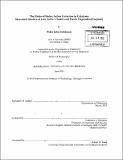The roles of redox active cofactors in catalysis : structural studies of iron sulfur cluster and flavin dependent enzymes
Author(s)
Goldman, Peter John
DownloadFull printable version (20.84Mb)
Other Contributors
Massachusetts Institute of Technology. Department of Chemistry.
Advisor
Catherine L. Drennan.
Terms of use
Metadata
Show full item recordAbstract
Cofactors are highly prevalent in biological systems and have evolved to take on many functions in enzyme catalysis. Two cofactors, flavin adenine dinucleotide (FAD) and [4Fe-4S] clusters, were originally determined to aid in electron transfer and redox chemistry. However, additional activities for these cofactors continue to be discovered. The study of FAD in the context of rebeccamycin and staurosporine biosynthesis has yielded another role for this cofactor in the enzyme StaC. A homolog of this enzyme, RebC, uses its FAD cofactor in the oxidation of 7-carboxy-K252c. StaC also uses 7-carboxy-K252 as a substrate, but its reaction does not result in a redox transformation. Biochemical and X-ray crystallographic methods were employed to determine that, indeed, the role of FAD in the StaC system is not to catalyze redox chemistry. Instead, FAD sterically drives an initial decarboxylation event. Subtle differences in the active sites of RebC and StaC promote this redox neutral decarboxylation, by activating water for a final protonation step. In another system, the characterization of the S-adenosyl-L-methionine (AdoMet) radical superfamily showed the versatility of these cofactors. In this superfamily, which includes over 40,000 unique sequences, [4Fe-4S] clusters are responsible for the initiation of radical chemistry. A recently described subclass of this superfamily, the dehydrogenases, require additional [4Fe-4S] cluster for activity. This requirement led to the hypothesis that these enzymes are catalyzing redox chemistry by directly ligating substrates to auxiliary (Aux) clusters. X-ray structures of 2-deoxy-scyllo-inosamine dehydrogenase (BtrN), required for the biosynthesis of 2-deoxystreptamine, and an anaerobic sulfatase maturating enzyme, anSMEcpe, which installs a required formylglycine posttranslational modification, refute this hypothesis. In these structures, substrate binding is distal from each enzymes' Aux clusters. However, the Aux cluster binding architecture shared between BtrN, anSMEcpe, and another AdoMet radical enzyme, MoaA, involved in molybdenum cofactor biosynthesis, suggests that the structural features will be a staple in the AdoMet radical superfamily, common to - 30% of the AdoMet radical reactions.
Description
Thesis (Ph. D.)--Massachusetts Institute of Technology, Dept. of Chemistry, 2013. Cataloged from PDF version of thesis. Includes bibliographical references.
Date issued
2013Department
Massachusetts Institute of Technology. Department of ChemistryPublisher
Massachusetts Institute of Technology
Keywords
Chemistry.